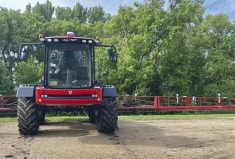Cleaning the sprayer is a critical part of every spray day. Pesticide residues clog and corrode equipment and can injure crops. So what is the best process for sprayer cleanout?
Operators should clean out their sprayers every time they switch pesticides, but respondents of a survey conducted by Colorado State University in 2013 said they only did it 60 per cent of the time. Operators should also clean out the sprayer when changing sites (e.g. moving from corn into soybeans) but only 31 per cent did so.
Finally, operators should clean out the sprayer at the end of the day, even if they intend to spray the same product the next day. Again, however, only 18 per cent did so.
Read Also

Producers aren’t panicking over tariffs and trade threats
The influence of tariff and trade uncertainity on farm business decisions.
These relatively low figures might partially account for the fact that 16 per cent of operators admitted to seeing off-target damage in recent years.
- From the Grainews website: Versatile debuts new SP sprayers
So, why aren’t producers cleaning their sprayers more frequently?
Respondents indicated that the biggest constraints aren’t time or cost, but the lack of a suitable place to clean the sprayer, the limited availability of clean water and limited places to put the rinsates.
Ideally, the sprayer should be cleaned at the site where product was applied. The location should not contaminate water supplies or nearby sensitive sites and should not be readily accessible to people, pets or livestock. The easiest way to do this is to have rinse water available in the field (e.g. on the sprayer or a support vehicle) so the rinsate can be applied back onto crop. Alternately, the sprayer can be cleaned at the loading area, but there should be a pad impervious to water with a sump to catch wash water and rinsate.
A review of several recommended protocols for tank cleaning reveals four key steps:
- Avoid having excess spray mix left over (except for the unavoidable volume in the ballast);
- Perform a low-volume rinse of the tank;
- Use some form of tank cleaner (as indicated on the pesticide label) in a second low-volume rinse, and;
- Finish with a third low-volume rinse.
According to the results of this survey, the size of the tank being cleaned was not a factor. Perhaps surprisingly, the impact of cleaning agents was unclear. What was obvious was that the more rinses, the more effective the cleanout. Further, as long as the volume used to rinse cleared any baffles in the tank, and was sufficient to rinse all surfaces, volumes as low as 10 per cent of the overall tank volume were able to clean the tank by 99 per cent when triple rinsing.
This is an edited version; the full report as shared with Country Guide can be found here.















